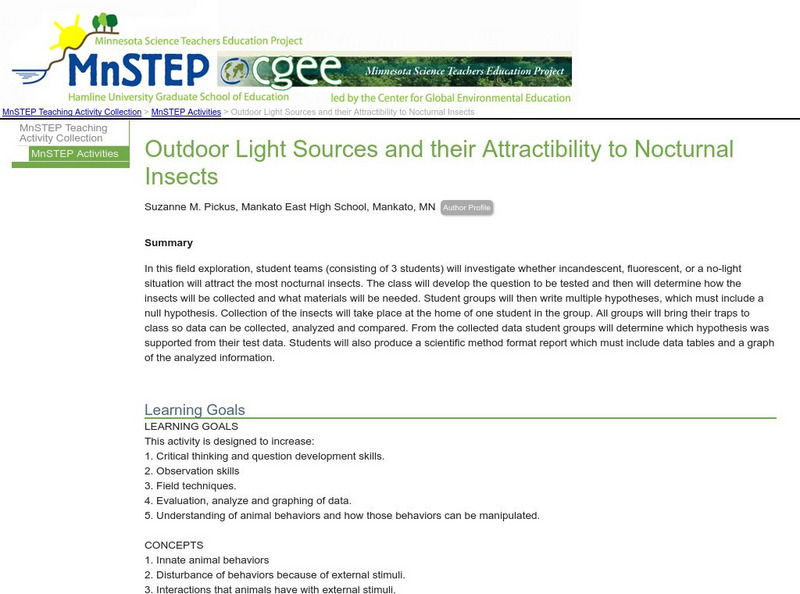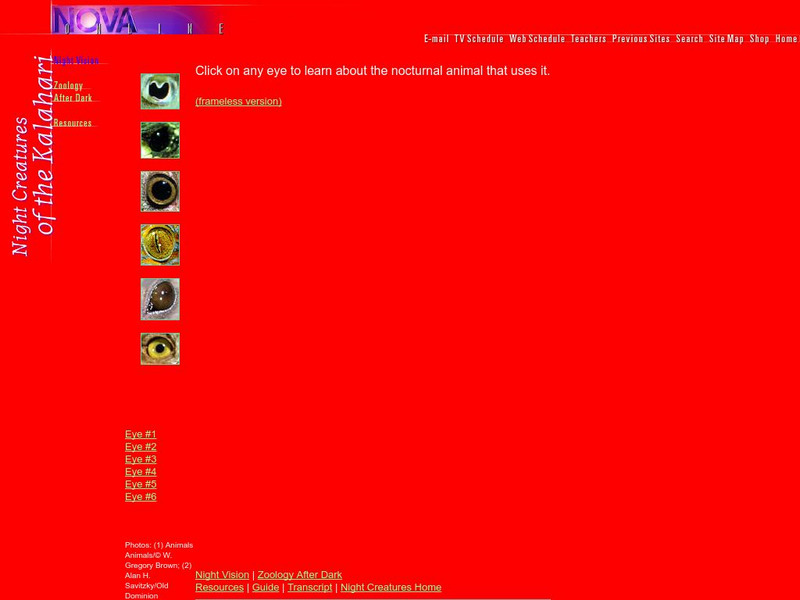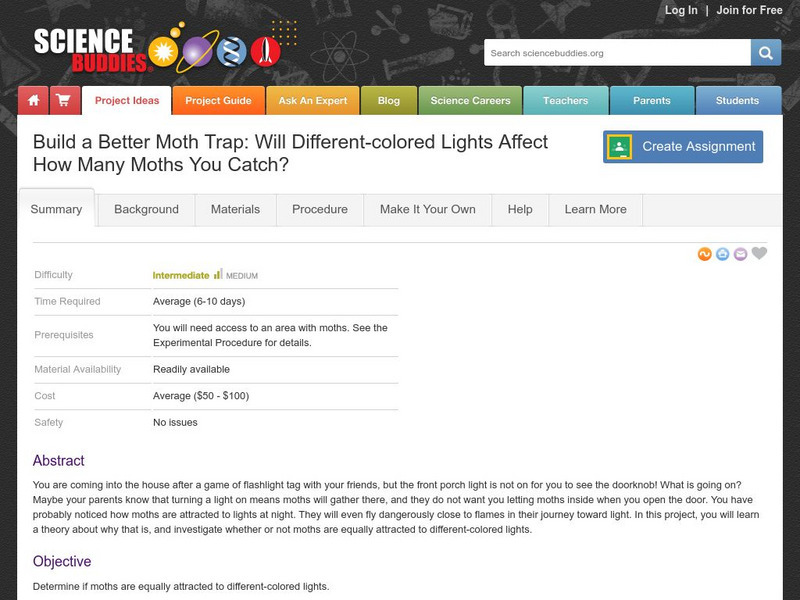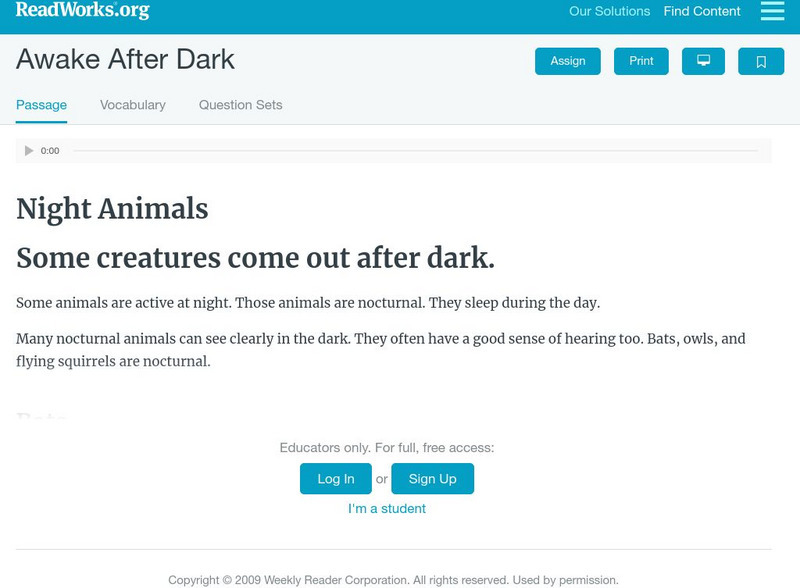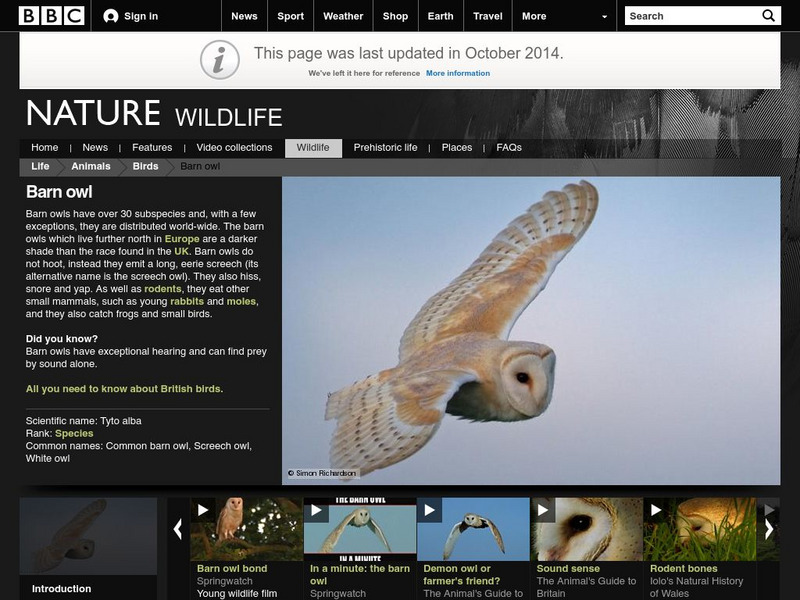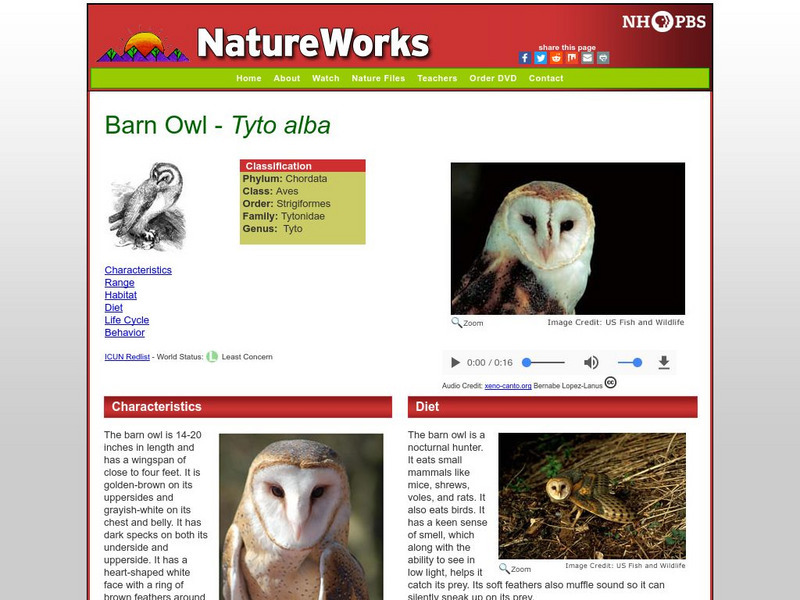Hi, what do you want to do?
Curated OER
Learning About Mammals
Students study the mammal classification and forms of them living in the United States. In this mammal study lesson plan, students read through orders of mammals that exist in the United States. Students also study the taxonomy of an...
Alabama Learning Exchange
Alex: Nocturnal Animals Lesson #1
This lesson can be part of a two-week integrated thematic unit on nocturnal animals. During this lesson, students will be introduced to nocturnal animals. They will have an opportunity to navigate web sites to learn more about nocturnal...
Science Education Resource Center at Carleton College
Serc: Outdoor Light Sources and Their Attractibility to Nocturnal Insects
A field investigation where students experiment with whether incandescent, fluorescent, or a no-light situation will attract the most nocturnal insects. Working in teams, students create a hypothesis and procedure to complete this field...
Khan Academy
Khan Academy: Whistler, Nocturne in Black and Gold: The Falling Rocket
View pictures of James Abbott McNeill Whistler's "Nocturne in Black and Gold" and read why this painting was involved in a court case.
Mark Harden's Artchive
The Artchive: Whistler: Nocturn in Black and Gold
Image of Whistler's painting, "Nocturn in Black and Gold: The Falling Rocket," with general information about the painting. Provides link to large image which can be made to adjust to the size of your screen.
Olga, Helen, Yuri and Sergey Mataev
Olga's Gallery: Nocturne in Blue and Silver
At Olga's Gallery, view an image of James Whistler's 1871-1872 painting "Nocturne in Blue and Silver."
PBS
Pbs Learning Media: Night Vision
This interactive feature from the NOVA: "Leopards of the Night" Web site highlights the nighttime habits and abilities of a wide range of nocturnal creatures.
Songs for Teaching
Sciences Songs All Day Long: Nocturnal Animals
By listening to this song your students will learn all of the animals that are awake during the night. They will equate the sounds they hear at night with the animals and their sounds in the song.
Alabama Learning Exchange
Alex: Nocturnal Animals Lesson #6: Skunks
In this lesson young scholars will learn interesting facts about skunks. They will also design a "nose guard" that people can wear to protect themselves against the smell of a skunk. Then students will have a chance to dramatize a...
Science Buddies
Science Buddies: Tick Tock, Does Your Mouse Know the Time on the Clock?
For this science fair project, you will build a device that records your nocturnal pet's activity by monitoring movement of its exercise wheel to see how it varies during the day and night. You can also experiment with various ways of...
Alabama Learning Exchange
Alex: Nocturnal Animals Lesson #4: Owls
During this lesson, students will visit various Internet sites to learn facts about owls. They will use this information to draw a picture of the owl food chain, dissect owl pellets, and write a poem about owls.
PBS
Pbs: Night Creatures of the Kalahari: Night Vision
Click on the eye and learn about the nocturnal animal it belongs to. Animals include cuttlefish, pit-viper, tarsier, flying gecko, fruit bat and the owl.
Science Buddies
Science Buddies: Build a Better Moth Trap With Different Colored Lights
Can you affect the behavior of moths by using different colored lights to attract them? This extensive science fair project from Science Buddies gives lots of suggestions on how to set up an experiment and variations of that experiment...
Read Works
Read Works: Awake After Dark
[Free Registration/Login Required] An informational text about nocturnal animals. A question sheet is available to help students build skills in reading comprehension.
Curated OER
Web Gallery of Art: Nocturne
An image of "Nocturne", created by Eilif Peterssen in 1887 (Oil on canvas, 82 x 82 cm).
Curated OER
Web Gallery of Art: Nocturne in Blue and Gold: Old Battersea Bridge
An image of "Nocturne in Blue and Gold: Old Battersea Bridge", created by James Abbot Mcneill Whistler from 1872-75 (Oil on canvas, 67 x 49 cm).
BBC
Bbc: Nature Wildfacts: Barn Owl
Take a look at these photos of beautiful barn owls. There is also a fact sheet next to the photos.
PBS
Nh Pbs: Nature Works: Barn Owl
Find out more about the barn owl when you explore this educational resource. This site features information on the habitat, range, reproduction, characteristics and more of this fascinating bird of prey.
Curated OER
Web Gallery of Art: Nativity in Nocturnal Light
An image of "Nativity in Nocturnal Light", created by Defendente Ferrari in 1510 (Mixed technique on panel, 37 x 27 cm).
Curated OER
Web Gallery of Art: Nocturnal Carousel in the Amphitheatre of the Boboli Gardens
An image of "Nocturnal Carousel in the Amphitheatre of the Boboli Gardens", created by Stefano Della Bella in 1637 (Oil on touchstone, 44 x 59 cm).
Curated OER
Web Gallery of Art: Nocturnal Seastorm
An image of "Nocturnal Seastorm", created by Claude-Joseph Vernet in 1752 (Oil on canvas, 73 x 98 cm).
Curated OER
Web Gallery of Art: Nocturnal Celebrations in via Eugenia at Venice
An image of "Nocturnal Celebrations in Via Eugenia at Venice", created by Ippolito Caffi in 1840 (Oil on canvas, 27 x 44 cm).
Curated OER
Web Gallery of Art: Nocturne in Black and Gold: The Falling Rocket
An image of "Nocturne in Black and Gold: The Falling Rocket", created by James Abbot Mcneill Whistler in 1875 (Oil on canvas, 60 x 47 cm).
Other popular searches
- Nocturnal Animals
- Nocturnal Animal Sounds
- Owls and Nocturnal Animals
- Preschool Nocturnal Animals
- Nocturnal Animals Lessons
- Nocturnal Animals Songs
- Nocturnal Desert Animals
- Poems for Nocturnal Animals
- K Nocturnal Animals
- Pre K Nocturnal Animals
- List Nocturnal Animals
- Tracks of Nocturnal Animals







